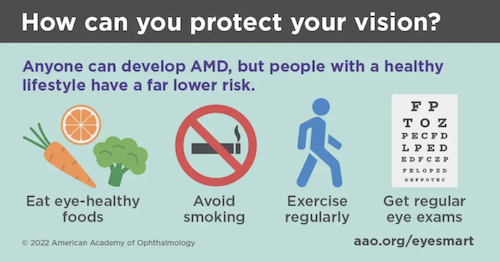February is Age-Related Macular Degeneration Awareness Month. A serious degenerative eye disease that can cause irreversible vision loss or blindness if left untreated, AMD is the most common reason patients are referred to Texas Retina. It is also one of the most common causes of poor vision after age 60.
How AMD Affects Vision
The visual symptoms of AMD involve loss of central vision. This can make it harder to see faces, read, drive or do close-up work like cooking or fixing things around the house.
Types of AMD
- Dry AMD is the most common form. It is characterized by accumulation of yellow deposits called drusen, thinning of the macula and gradual deterioration of central vision.
- Geographic atrophy (GA) is a late stage of dry AMD and involves chronic and irreversible progressive destruction (atrophy) of central retinal cells and underlying blood vessels due to chronic inflammation.
- Wet AMD is less common but more serious. With this form of the disease, abnormal blood vessels grow under the retina and may leak, causing accumulation of blood or other fluid that can cause scarring of the macula.
Reducing Your Risk for Developing AMD
The American Academy of Ophthalmology (AAO) has identified seven essential steps to take control of your eye health and reduce your risk of AMD:
- Get regular comprehensive medical eye exams. AMD often has no early warning signs, so getting regular comprehensive eye exams from an ophthalmologist is critical to diagnosing and treating the eye disease in its early stages. The Academy recommends that adults with no signs or risk factors for eye disease get a baseline eye disease screening at age 40 — the time when early signs of disease and changes in vision may start to occur. By age 65, the Academy recommends getting an exam every one to two years, even in the absence of symptoms or eye problems.
- Quit smoking. Numerous studies show smoking increases the risk of developing AMD, and the speed at which it progresses. Smokers are twice as likely to develop macular degeneration compared with a nonsmoker.
- Eat a well-balanced diet. Many studies demonstrate that eating a diet rich in fruits, vegetables, and nutrient-packed foods, such as salmon and nuts, may reduce the risk of AMD. Research also suggests that patients who ate fresh fish, an important source of omega-3s, were at lower risk of developing AMD.
- Take the right kind of vitamins. Vitamins can delay progression of advanced AMD and help people keep their vision longer if they have intermediate AMD or advanced AMD in one eye. But make sure it’s the right combination of vitamins. A recent study found that some of the top-selling products do not contain identical ingredient dosages to eye vitamin formulas proven effective in clinical trials.
- Exercise regularly. Exercising three times a week can reduce the risk of developing wet AMD by 70 percent. Studies also show that physical activity may lower the odds of both early and late stages of AMD.
- Monitor your sight with an Amsler Grid. This simple, daily routine takes less than one minute and can help people with AMD save more of their vision. Using this grid is essential to finding any vision changes that are not obvious, so you can report them to your ophthalmologist.
- Know your family’s eye health history. If you have a close relative with AMD, you have a 50 percent greater chance of developing the condition. Before your next eye exam, speak with your family about their eye health history. You may need more frequent eye exams based on your family history.
Click here to learn more about AMD and current treatment options.
In addition, Texas Retina is currently involved in several clinical trials to explore new AMD treatment options. If you are interested in participating in a trial, please inform your Texas Retina physician during your next visit.


